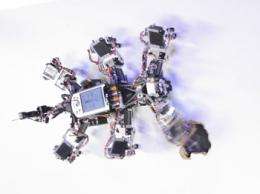Organized chaos gets robots going (Update)

(PhysOrg.com) -- Even simple insects can generate quite different movement patterns with their six legs. The animal uses various gaits depending on whether it crawls uphill or downhill, slowly or fast. Scientists from Gottingen have now developed a walking robot, which can flexibly and autonomously switch between different gaits. The success of their solution lies in its simplicity: a small and simple network with just a few connections can create very diverse movement patterns. To this end, the robot uses a mechanism for "chaos control."
In humans and animals, periodically recurring movements like walking or breathing are controlled by small neural circuits called "central pattern generators" (CPG). Scientists have been using this principle in the development of walking machines. To date, typically one separate CPG was needed for every gait. The robot receives information about its environment via several sensors - about whether there is an obstacle in front of it or whether it climbs a slope. Based on this information, it selects the CPG controlling the gait that is appropriate for the respective situation.
The robot developed by the Göttingen scientists now manages the same task with only one CPG that generates entirely different gaits and which can switch between these gaits in a flexible manner. This CPG is a tiny network consisting of two circuit elements. The secret of its functioning lies in the so-called "chaos control". If uncontrolled, the CPG produces a chaotic activity pattern. This activity, however, can very easily be controlled by the sensor inputs into periodic patterns that determine the gait. Depending on the sensory input signal, different patterns - and thus different gaits - are generated.
The connection between sensory properties and CPG can either be preprogrammed or learned by the robot from experience. The scientists use a key example to show how this works: the robot can autonomously learn to walk up a slope with as little energy input as possible. As soon as the robot reaches a slope, a sensor shows that the energy consumption is too high. Thereupon, the connection between the sensor and the control input of the CPG is varied until a gait is found that allows the robot to consume less energy. Once the right connections have been established, the robot has learned the relation between slope and gait. When it tries to climb the hill a second time, it will immediately adopt the appropriate gait.
In the future, the robot will also be equipped with a memory device which will enable it to complete movements even after the sensory input ceases to exist. In order to walk over an obstacle, for instance, the robot would have to take a large step with each of its six legs. "Currently, the robot would not be able to handle this task - as soon as the obstacle is out of sight, it no longer knows which gait to use," says Marc Timme, scientist at the Max Planck Institute for Dynamics and Self-Organization. "Once the robot is equipped with a motor memory, it will be capable to use foresight and plan its movements".
More information: Silke Steingrube, Marc Timme, Florentin Wörgötter and Poramate Manoonpong, Self-organized adaptation of a simple neural circuit enables complex robot behaviour , Nature Physics, January 17th, 2010 (DOI: 10.1038/NPHYS1508)
Provided by Max-Planck-Gesellschaft




















